Synthesis of Nickel Spinel Ferrites Nanoparticles Coated with Thermally Reduced Graphene Oxide for EMI Shielding in the Microwave, UV, and NIR Regions
Abstract
:1. Introduction
2. Materials and Methods
2.1. Preparation of Nickel Ferrite (NiFe)
2.2. Preparation of Nickel Ferrite (NiFe) Coated with Thermally Reduced Graphene Oxide (TRGO) Nanoparticles (TRGO-NiFe)
2.3. Preparation of Nanocomposite Films
2.4. Characterization
2.4.1. X-ray Diffraction
2.4.2. Scanning Electron Microscopy
2.4.3. UV/Vis/NIR Spectroscopy
2.4.4. DC Conductivity
2.4.5. Vector Network Analyzer
3. Results and Discussion
3.1. X-ray Diffraction
3.2. Scanning Electron Microscopy
3.3. DC Conductivity
3.4. EMI Shielding in UV/Vis/NIR Region
3.5. EMI Shielding in the Microwave Region Calculated through Impedance Parameters
3.6. EMI Shielding in the Microwave Region Measured through Scattering Parameters
4. Conclusions
Author Contributions
Funding
Institutional Review Board Statement
Informed Consent Statement
Data Availability Statement
Acknowledgments
Conflicts of Interest
References
- Subramanian, J.; Kumar, S.V.; Venkatachalam, G.; Gupta, M.; Singh, R. An Investigation of EMI Shielding Effectiveness of Organic Polyurethane Composite Reinforced with MWCNT-CuO-Bamboo Charcoal Nanoparticles. J. Electron. Mater. 2021, 50, 1282–1291. [Google Scholar] [CrossRef]
- Zahid, M.; Nawab, Y.; Gulzar, N.; Rehan, Z.A.; Shakir, M.F.; Afzal, A.; Rashid, I.A.; Tariq, A. Fabrication of reduced graphene oxide (RGO) and nanocomposite with thermoplastic polyurethane (TPU) for EMI shielding application. J. Mater. Sci. Mater. Electron. 2019, 31, 967–974. [Google Scholar] [CrossRef]
- Bhattacharjee, Y.; Arief, I.; Bose, S. Recent trends in multi-layered architectures towards screening electromagnetic radiation: Challenges and perspectives. J. Mater. Chem. C 2017, 5, 7390–7403. [Google Scholar] [CrossRef]
- Ma, X.; Shen, B.; Zhang, L.; Liu, Y.; Zhai, W.; Zheng, W. Porous superhydrophobic polymer/carbon composites for lightweight and self-cleaning EMI shielding application. Compos. Sci. Technol. 2018, 158, 86–93. [Google Scholar] [CrossRef]
- Islam, A.; Khan, A.N.; Shakir, M.F. Strengthening of β polymorph in PVDF/FLG and PVDF/GO nanocomposites. Mater. Res. Express 2020, 7, 015017. [Google Scholar] [CrossRef] [Green Version]
- Liu, W.; Yao, T.; Jia, K.; Gu, J.; Wang, D.; Wei, X. Flexible and thermal conducting multi-walled carbon nanotubes/waterborne polyurethane composite film from in situ polymerization for efficient electromagnetic interference shielding. J. Mater. Sci. Mater. Electron. 2021, 32, 4393–4403. [Google Scholar] [CrossRef]
- Gulzar, N.; Zubair, K.; Shakir, M.F.; Zahid, M.; Nawab, Y.; Rehan, Z.A. Effect on the EMI Shielding Properties of Cobalt Ferrites and Coal-Fly-Ash Based Polymer Nanocomposites. J. Supercond. Nov. Magn. 2020, 33, 3519–3524. [Google Scholar] [CrossRef]
- Zahid, M.; Anum, R.; Siddique, S.; Shakir, H.F.; Rehan, Z. Polyaniline-based nanocomposites for electromagnetic interference shielding applications: A review. J. Thermoplast. Compos. Mater. 2021. [Google Scholar] [CrossRef]
- Jia, X.; Shen, B.; Zhang, L.; Zheng, W. Construction of shape-memory carbon foam composites for adjustable EMI shielding under self-fixable mechanical deformation. Chem. Eng. J. 2021, 405, 126927. [Google Scholar] [CrossRef]
- Hou, Y.; Cheng, L.; Zhang, Y.; Du, X.; Zhao, Y.; Yang, Z. High temperature electromagnetic interference shielding of lightweight and flexible ZrC/SiC nanofiber mats. Chem. Eng. J. 2021, 404, 126521. [Google Scholar] [CrossRef]
- Sabet, M.; Jahangiri, H.; Ghashghaei, E. Improving microwave absorption of the polyaniline by carbon nanotube and needle-like magnetic nanostructures. Synth. Met. 2017, 224, 18–26. [Google Scholar] [CrossRef]
- Radwan, R.M.; Mahdy, A.M.; Abdel-Salam, M.; Samy, M.M. Electric field mitigation under extra high voltage power lines. IEEE Trans. Dielectr. Electr. Insul. 2013, 20, 54–62. [Google Scholar] [CrossRef]
- Yoshizawa, K.; Noguchi, S.; Igarashi, H. Influence of Magnetic Property of Ferromagnetic Shield on High Field Magnet Analysis. IEEE Trans. Appl. Supercond. 2010, 21, 2088–2091. [Google Scholar] [CrossRef] [Green Version]
- Ren, S.; Guo, S.; Liu, X.; Liu, Q. Shielding Effectiveness of Double-Layer Magnetic Shield of Current Comparator Under Radial Disturbing Magnetic Field. IEEE Trans. Magn. 2016, 52, 1–7. [Google Scholar] [CrossRef]
- Shakir, M.F.; Rashid, I.A.; Tariq, A.; Nawab, Y.; Afzal, A.; Nabeel, M.; Naseem, A.; Hamid, U. EMI Shielding Characteristics of Electrically Conductive Polymer Blends of PS/PANI in Microwave and IR Region. J. Electron. Mater. 2020, 49, 1660–1665. [Google Scholar] [CrossRef]
- Shakir, M.F.; Tariq, A.; Rehan, Z.A.; Nawab, Y.; Rashid, I.A.; Afzal, A.; Hamid, U.; Raza, F.; Zubair, K.; Rizwan, M.S.; et al. Effect of Nickel-spinal-Ferrites on EMI shielding properties of polystyrene/polyaniline blend. SN Appl. Sci. 2020, 2, 1–13. [Google Scholar] [CrossRef] [Green Version]
- Afzal, I.; Saleem, S.; Skalicky, M.; Javed, T.; Bakhtavar, M.A.; Kamran, M.; Shahid, M.; Sohail Saddiq, M.; Afzal, A.; Shafqat, N.; et al. Magnetic field treatments improves sunflower yield by inducing physiological and biochemical modulations in seeds. Molecules 2021, 26. [Google Scholar] [CrossRef]
- Anum, R.; Zahid, M.; Siddique, S.; Shakir, H.F.; Rehan, Z. PVC based flexible nanocomposites with the incorporation of Polyaniline and Barium Hexa-Ferrite nanoparticles for the shielding against EMI, NIR, and thermal imaging cameras. Synth. Met. 2021, 277, 116773. [Google Scholar] [CrossRef]
- Siddique, S.; Zahid, M.; Anum, R.; Shakir, H.F.; Rehan, Z. Fabrication and characterization of PVC based flexible nanocomposites for the shielding against EMI, NIR, and thermal imaging signals. Results Phys. 2021, 24, 104183. [Google Scholar] [CrossRef]
- Zubair, K.; Shakir, M.F. Effect of Polymer Matrix in Polymer/trGO Nano-Composite for EMI Shielding Application in Microwave and Infrared Region. Key Eng. Mater. 2021, 875, 153–159. [Google Scholar] [CrossRef]
- Zubair, K.; Ashraf, A.; Gulzar, H.; Shakir, H.M.F.; Nawab, Y.; Rehan, Z.A.; Rashid, I.A. Study of mechanical, electrical and EMI shielding properties of polymer-based nanocomposites incorporating polyaniline coated graphene nanoparticles. Nano Express 2021, 2, 010038. [Google Scholar] [CrossRef]
- Zubair, K.; Shakir, M.F.; Afzal, A.; Rehan, Z.A.; Nawab, Y. Effect of barium hexaferrites and thermally reduced graphene oxide on emi shielding properties in polymer composites. J. Supercond. Nov. Magn. 2021, 34, 201–210. [Google Scholar] [CrossRef]
- Shahzad, F.; Alhabeb, M.; Hatter, C.B.; Anasori, B.; Hong, S.M.; Koo, C.M.; Gogotsi, Y. Electromagnetic interference shielding with 2D transition metal carbides (MXenes). Science 2016, 353, 1137–1140. [Google Scholar] [CrossRef] [PubMed] [Green Version]
- Chung, D.D.L. Electromagnetic interference shielding effectiveness of carbon materials. Materials 2001, 39, 279–285. [Google Scholar] [CrossRef]
- Chen, Z.; Xu, C.; Ma, C.; Ren, W.; Cheng, H.-M. Lightweight and Flexible Graphene Foam Composites for High-Performance Electromagnetic Interference Shielding. Adv. Mater. 2013, 25, 1296–1300. [Google Scholar] [CrossRef] [PubMed]
- Rashid, I.A.; Tariq, A.; Shakir, H.F.; Afzal, A.; Ali, F.; Abuzar, M.; Haider, T. Electrically conductive epoxy/polyaniline composite fabrication and characterization for electronic applications. J. Reinf. Plast. Compos. 2021. [Google Scholar] [CrossRef]
- Shakir, H.F.; Khan, A.N.; Khan, R.; Javed, S.; Tariq, A.; Azeem, M.; Riaz, A.; Shafqat, A.; Cheema, H.; Akram, M.A.; et al. EMI shielding properties of polymer blends with inclusion of graphene nano platelets. Results Phys. 2019, 14, 102365. [Google Scholar] [CrossRef]
- Zahid, M.; Siddique, S.; Anum, R.; Shakir, M.F.; Nawab, Y.; Rehan, Z.A. M-Type Barium Hexaferrite-Based Nanocomposites for EMI Shielding Application: A Review. J. Supercond. Nov. Magn. 2021, 34, 1019–1045. [Google Scholar] [CrossRef]
- Yu, J.; Cui, Z.; Lu, J.; Zhao, J.; Zhang, Y.; Fan, G.; Liu, S.; He, Y.; Yu, Y.; Qi, D. Integrated hierarchical macrostructures of flexible basalt fiber composites with tunable electromagnetic interference (EMI) shielding and rapid electrothermal response. Compos. Part B Eng. 2021, 224, 109193. [Google Scholar] [CrossRef]
- Shakir, H.F.; Tariq, A.; Afzal, A.; Rashid, I.A. Mechanical, thermal and EMI shielding study of electrically conductive polymeric hybrid nano-composites. J. Mater. Sci. Mater. Electron. 2019, 30, 17382–17392. [Google Scholar] [CrossRef]
- Zhang, X.; Chen, J.; Liu, T. Physical origin of distinct mechanical properties of polymer tethered graphene nanosheets reinforced polymer nanocomposites revealed by nonequilibrium molecular dynamics simulations. Macromol. Theory Simul. 2021, 2100044. [Google Scholar] [CrossRef]
- Gahlout, P.; Choudhary, V. EMI shielding response of polypyrrole-MWCNT/polyurethane composites. Synth. Met. 2020, 266, 116414. [Google Scholar] [CrossRef]
- Nejati, K.; Zabihi, R. Preparation and magnetic properties of nano size nickel ferrite particles using hydrothermal method. Chem. Central J. 2012, 6, 23. [Google Scholar] [CrossRef] [PubMed] [Green Version]
- Saboor, A.; Khan, A.N.; Jan, R.; Sharif, S.; Khan, M. Mechanical, dielectric and EMI shielding response of styrene acrylonitrile, styrene acrylonitrile/polyaniline polymer blends, upon incorporation of few layer graphene at low filler loadings. J. Polym. Res. 2018, 25, 248. [Google Scholar] [CrossRef]
- Pawar, S.P.; Biswas, S.; Kar, G.P.; Bose, S. High frequency millimetre wave absorbers derived from polymeric nanocomposites. Polym. 2016, 84, 398–419. [Google Scholar] [CrossRef]
- Al-Saleh, M.; Saadeh, W.; Sundararaj, U. EMI shielding effectiveness of carbon based nanostructured polymeric materials: A comparative study. Carbon 2013, 60, 146–156. [Google Scholar] [CrossRef]
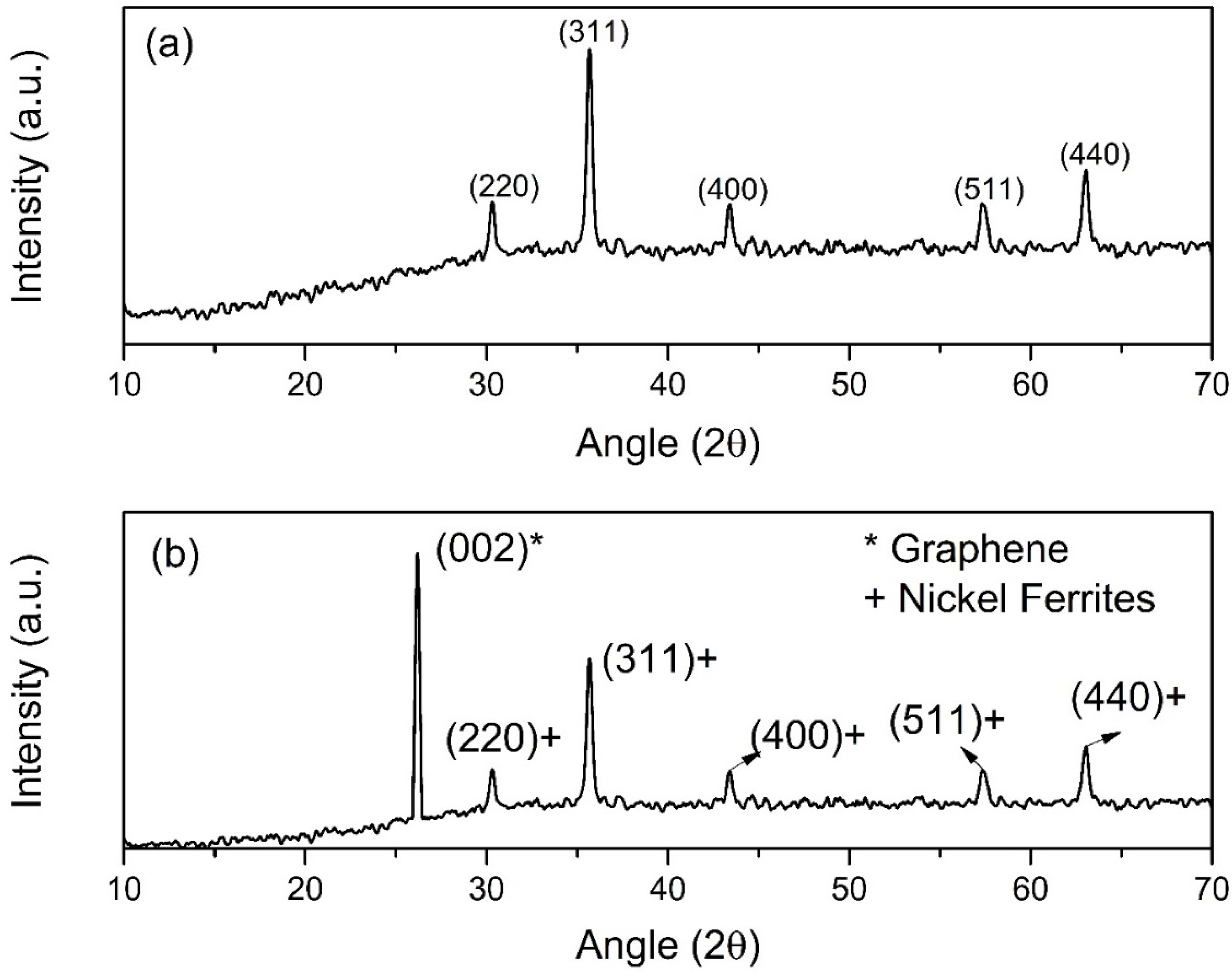
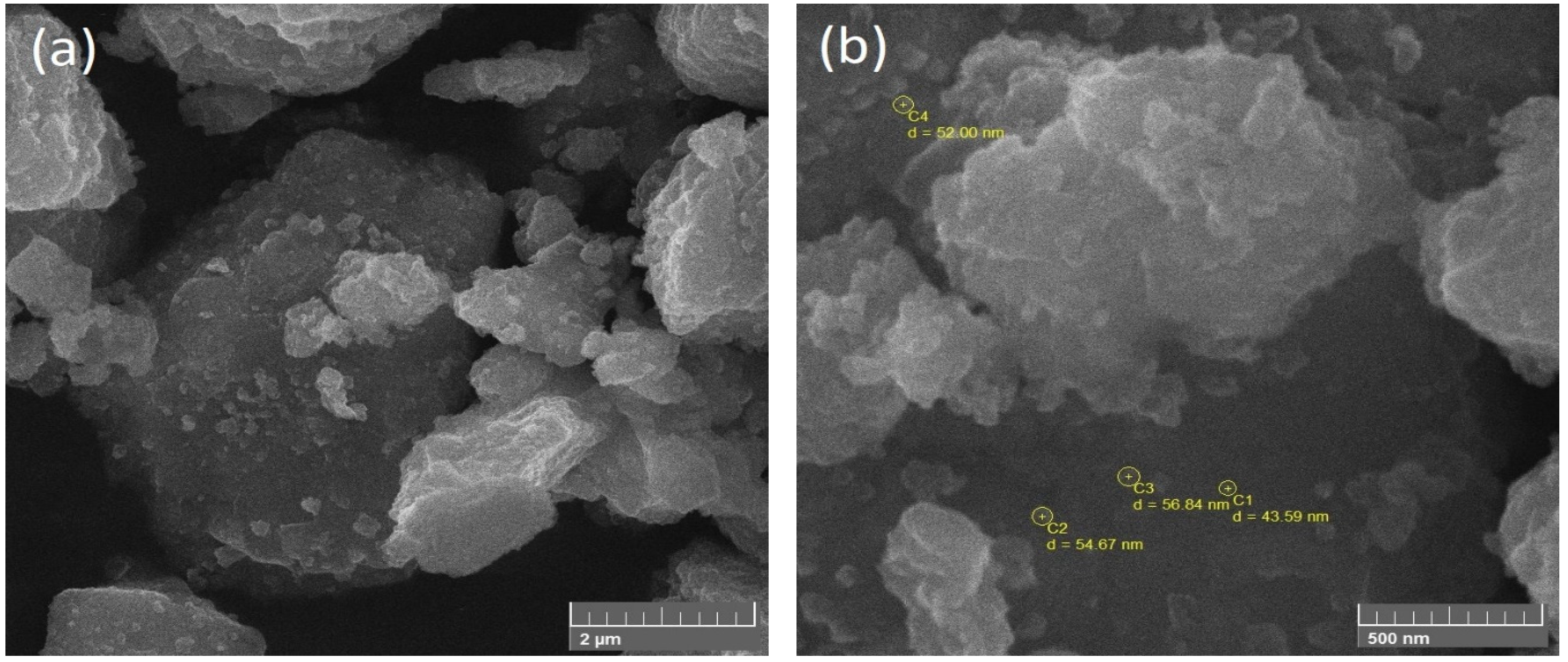


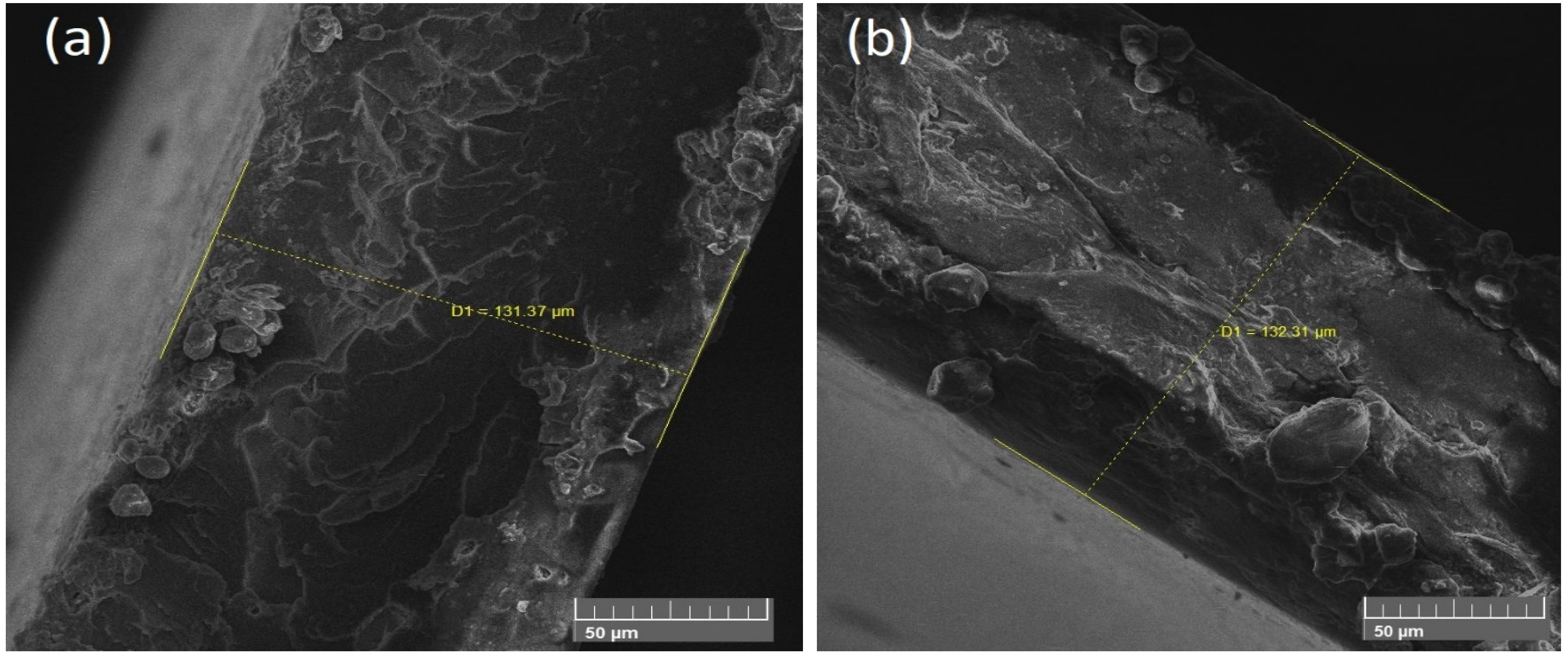
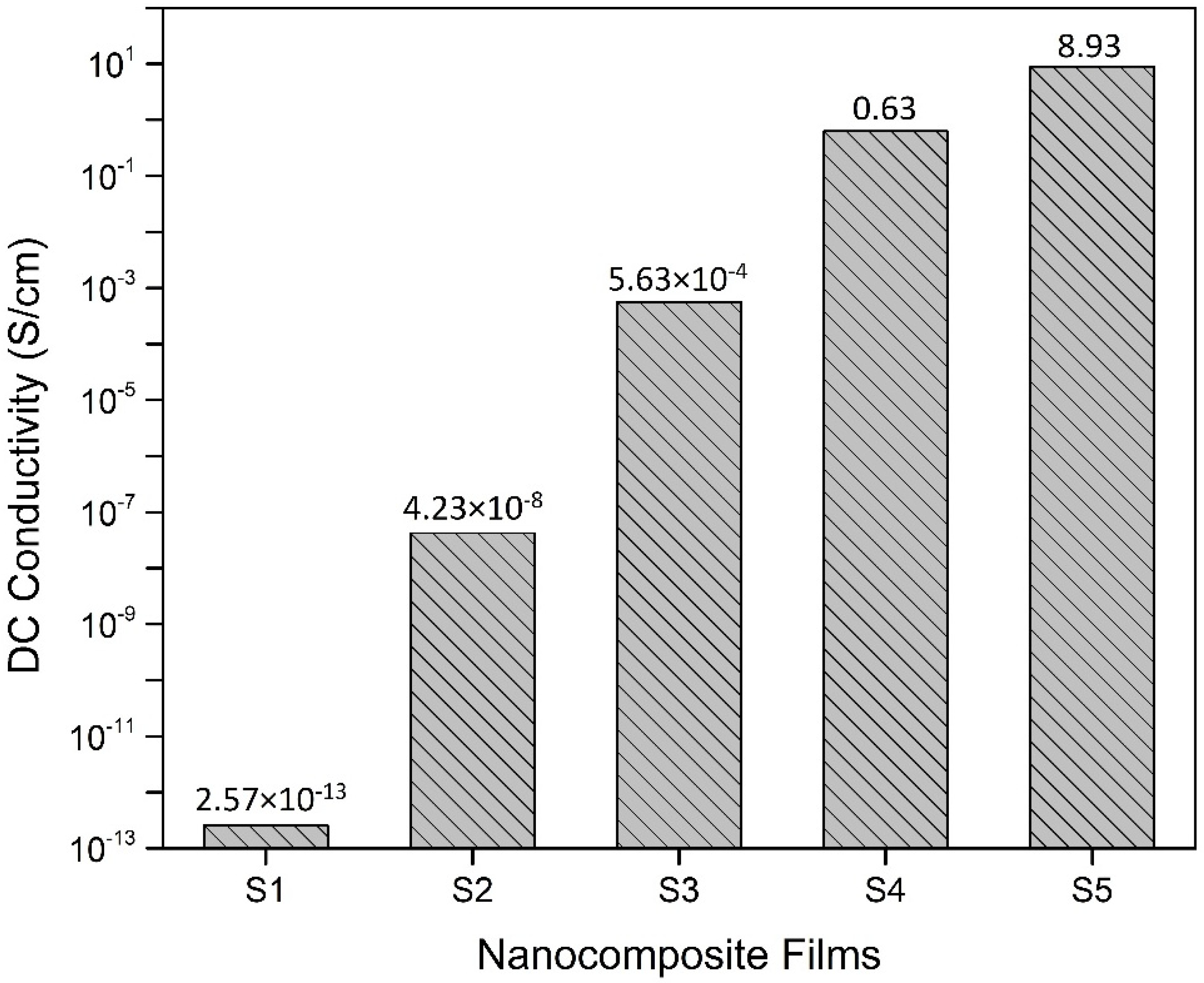
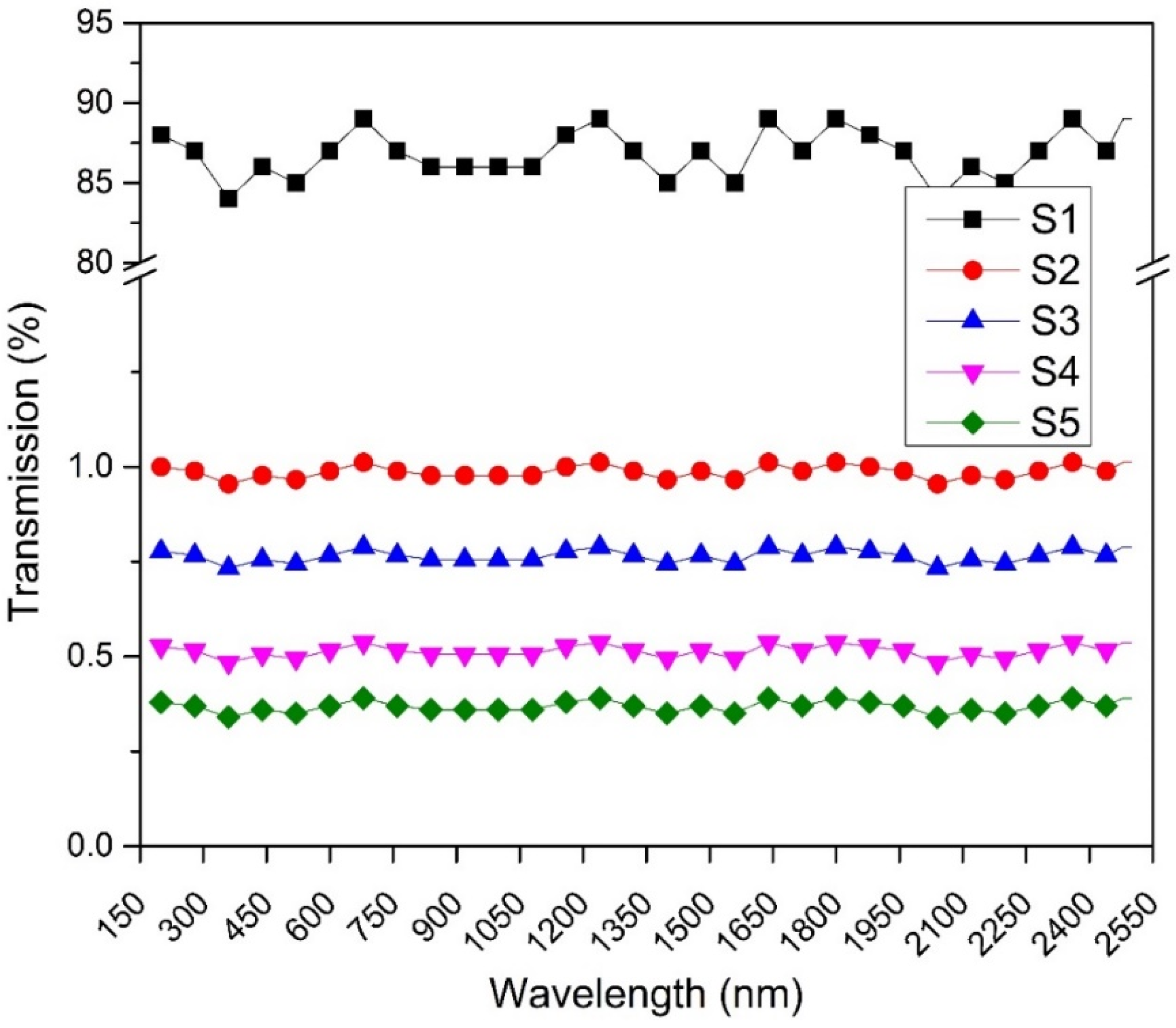
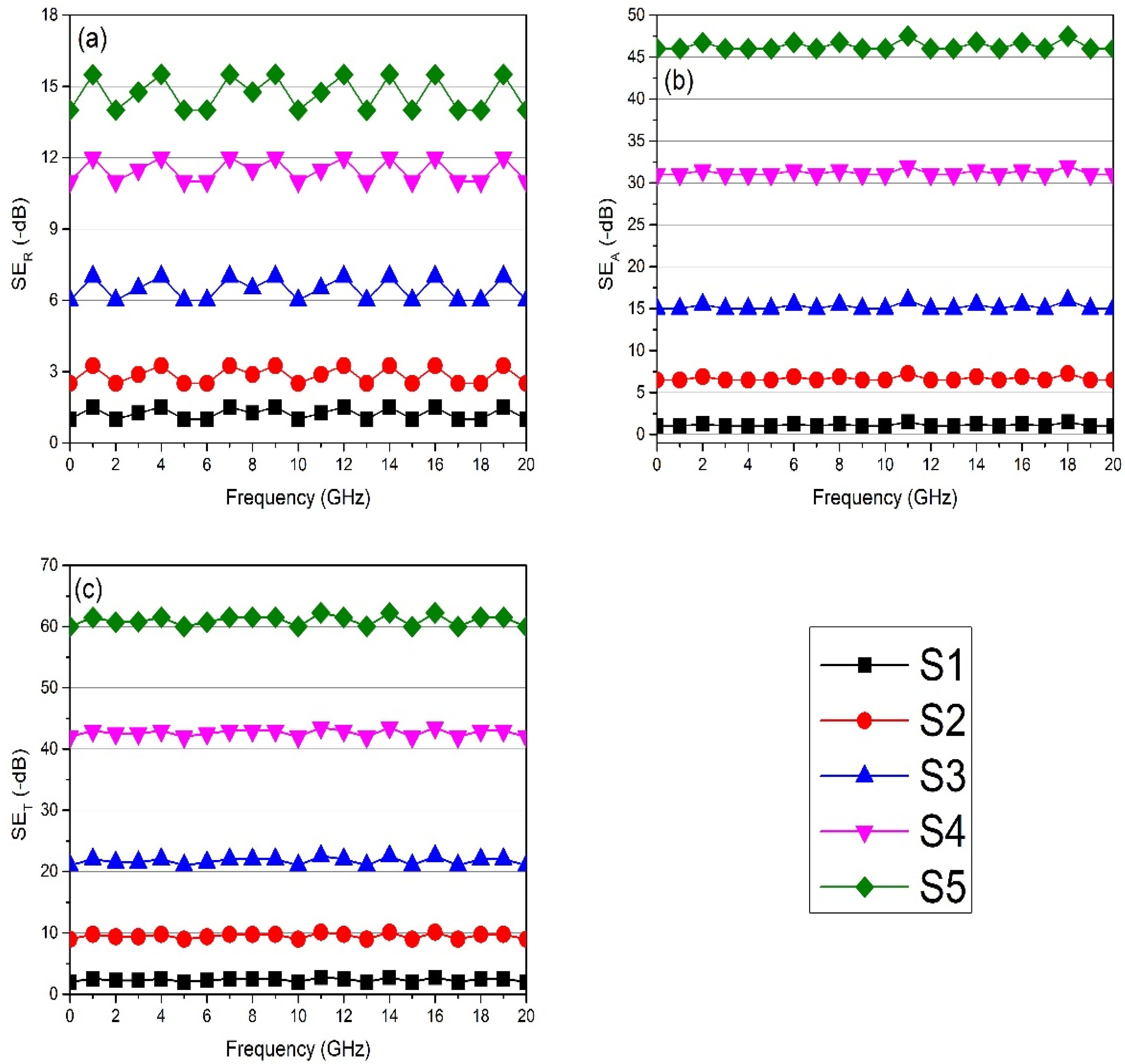

| Sr. No. | Sample Name | PVC (wt%) | NiFe-TRGO (wt%) | Nanocomposite Film Thickness (µm) |
|---|---|---|---|---|
| 1 | S1 | 100 | - | 131 |
| 2 | S2 | 95 | 5 | 133 |
| 3 | S3 | 85 | 15 | 132 |
| 4 | S4 | 70 | 30 | 130 |
| 5 | S5 | 60 | 40 | 129 |
Publisher’s Note: MDPI stays neutral with regard to jurisdictional claims in published maps and institutional affiliations. |
© 2021 by the authors. Licensee MDPI, Basel, Switzerland. This article is an open access article distributed under the terms and conditions of the Creative Commons Attribution (CC BY) license (https://creativecommons.org/licenses/by/4.0/).
Share and Cite
Mansha, A.; Zubair, K.; Rehan, Z.A.; Shakir, H.M.F.; Javed, T.; Shabbir, R.; Mustafa, S.K.; Mora-Poblete, F.; Zhou, J.-R.; Kumar, U.; et al. Synthesis of Nickel Spinel Ferrites Nanoparticles Coated with Thermally Reduced Graphene Oxide for EMI Shielding in the Microwave, UV, and NIR Regions. Polymers 2021, 13, 3316. https://doi.org/10.3390/polym13193316
Mansha A, Zubair K, Rehan ZA, Shakir HMF, Javed T, Shabbir R, Mustafa SK, Mora-Poblete F, Zhou J-R, Kumar U, et al. Synthesis of Nickel Spinel Ferrites Nanoparticles Coated with Thermally Reduced Graphene Oxide for EMI Shielding in the Microwave, UV, and NIR Regions. Polymers. 2021; 13(19):3316. https://doi.org/10.3390/polym13193316
Chicago/Turabian StyleMansha, Asim, Khadija Zubair, Zulfiqar Ahmad Rehan, H. M. Fayzan Shakir, Talha Javed, Rubab Shabbir, Syed Khalid Mustafa, Freddy Mora-Poblete, Jing-Ru Zhou, Uttam Kumar, and et al. 2021. "Synthesis of Nickel Spinel Ferrites Nanoparticles Coated with Thermally Reduced Graphene Oxide for EMI Shielding in the Microwave, UV, and NIR Regions" Polymers 13, no. 19: 3316. https://doi.org/10.3390/polym13193316
APA StyleMansha, A., Zubair, K., Rehan, Z. A., Shakir, H. M. F., Javed, T., Shabbir, R., Mustafa, S. K., Mora-Poblete, F., Zhou, J.-R., Kumar, U., Al-Harbi, M. S., & Hassan, M. M. (2021). Synthesis of Nickel Spinel Ferrites Nanoparticles Coated with Thermally Reduced Graphene Oxide for EMI Shielding in the Microwave, UV, and NIR Regions. Polymers, 13(19), 3316. https://doi.org/10.3390/polym13193316








